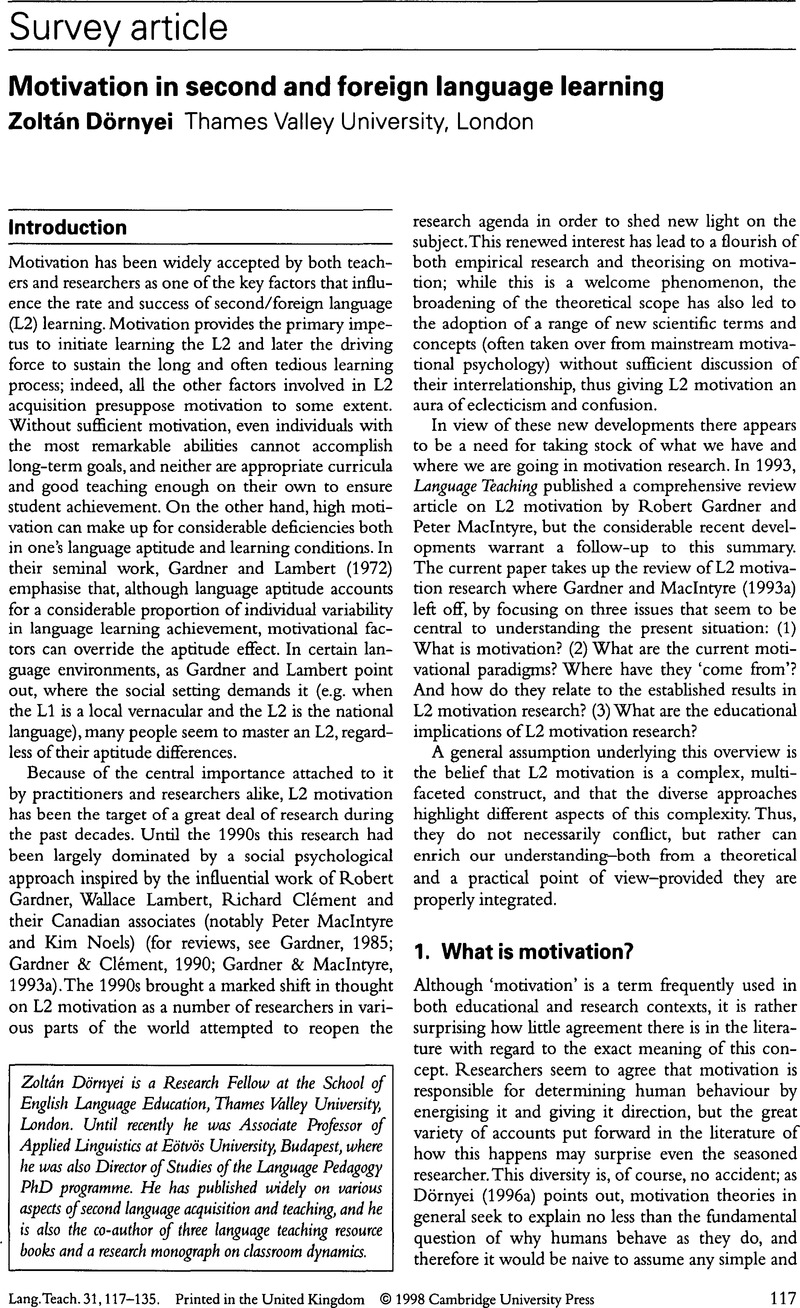Crossref Citations
This article has been cited by the following publications. This list is generated based on data provided by Crossref.
Luchini, Pedro Luis
and
Ferreiro, Gabriela Mariel
1970.
Autoevaluación y evaluación negociada entre docente y alumnos en la clase de pronunciación inglesa: un estudio con estudiantes argentinos.
Didáctica. Lengua y Literatura,
Vol. 30,
Issue. ,
p.
137.
Gardner, R. C.
Masgoret, Anne-Marie
and
Tremblay, Paul F.
1999.
Home Background Characteristics and Second Language Learning.
Journal of Language and Social Psychology,
Vol. 18,
Issue. 4,
p.
419.
Elder, Cathie
Warren, Jane
Hajek, John
Manwaring, Diane
and
Davies, Alan
1999.
Metalinguistic knowledge.
Australian Review of Applied Linguistics,
Vol. 22,
Issue. 1,
p.
81.
Hotho, Sabine
1999.
Motivation in anab initioGerman classroom.
The Language Learning Journal,
Vol. 20,
Issue. 1,
p.
37.
Dörnyei, Zoltán
and
Kormos, Judit
2000.
The role of individual and social variables in oral task performance.
Language Teaching Research,
Vol. 4,
Issue. 3,
p.
275.
Hotho, Sabine
2000.
“Same” or “Different”? A Comparative Examination of Classroom Factors in Second Language Settings.
Foreign Language Annals,
Vol. 33,
Issue. 3,
p.
320.
Ganschow, Leonore
and
Sparks, Richard
2001.
Learning difficulties and foreign language learning: A review of research and instruction.
Language Teaching,
Vol. 34,
Issue. 2,
p.
79.
Hay, Josiane
2001.
Le projet personnel en cours de langue : une expérience en milieu scientifique.
Les Cahiers de l'APLIUT,
p.
65.
Noels, Kimberly
Clément, Richard
and
Pelletier, Luc
2001.
Intrinsic, Extrinsic, and Integrative Orientations of French Canadian Learners of English.
The Canadian Modern Language Review,
Vol. 57,
Issue. 3,
p.
424.
Brown, Kim
and
Fletcher, Alan
2002.
Disaffection or disruptive engagement? a collaborative inquiry into pupils' behaviour and their perceptions of their learning in modern language lessons.
Pedagogy, Culture & Society,
Vol. 10,
Issue. 2,
p.
169.
Williams, Marion
Burden, Robert
and
Lanvers, Ursula
2002.
‘French is the Language of Love and Stuff’: Student perceptions of issues related to motivation in learning a foreign language.
British Educational Research Journal,
Vol. 28,
Issue. 4,
p.
503.
Dörnyei, Zoltán
and
Skehan, Peter
2003.
The Handbook of Second Language Acquisition.
p.
589.
Robinson, Peter
2003.
The Handbook of Second Language Acquisition.
p.
631.
Noels, Kimberly A.
2003.
Learning Spanish as a Second Language: Learners’ Orientations and Perceptions of Their Teachers’ Communication Style.
Language Learning,
Vol. 53,
Issue. S1,
p.
97.
Baker, Susan C.
and
MacIntyre, Peter D.
2003.
The Role of Gender and Immersion in Communication and Second Language Orientations.
Language Learning,
Vol. 53,
Issue. S1,
p.
65.
Pachler, Norbert
2003.
Foreign language teaching as an evidence-based profession?.
The Language Learning Journal,
Vol. 27,
Issue. 1,
p.
4.
Adams, Rebecca
2003.
L2 output, reformulation and noticing: Implications for IL development.
Language Teaching Research,
Vol. 7,
Issue. 3,
p.
347.
Gan, Zhengdong
Humphreys, Gillian
and
Hamp‐Lyons, Liz
2004.
Understanding Successful and Unsuccessful EFL Students in Chinese Universities.
The Modern Language Journal,
Vol. 88,
Issue. 2,
p.
229.
Dewey, Dan P.
2004.
Connections Between Teacher and Student Attitudes Regarding Script Choice in First‐Year Japanese Language Classrooms.
Foreign Language Annals,
Vol. 37,
Issue. 4,
p.
567.
Mori, Setsuko
2004.
Significant Motivational Predictors of the Amount of Reading By Efl Learners in Japan.
RELC Journal,
Vol. 35,
Issue. 1,
p.
63.





